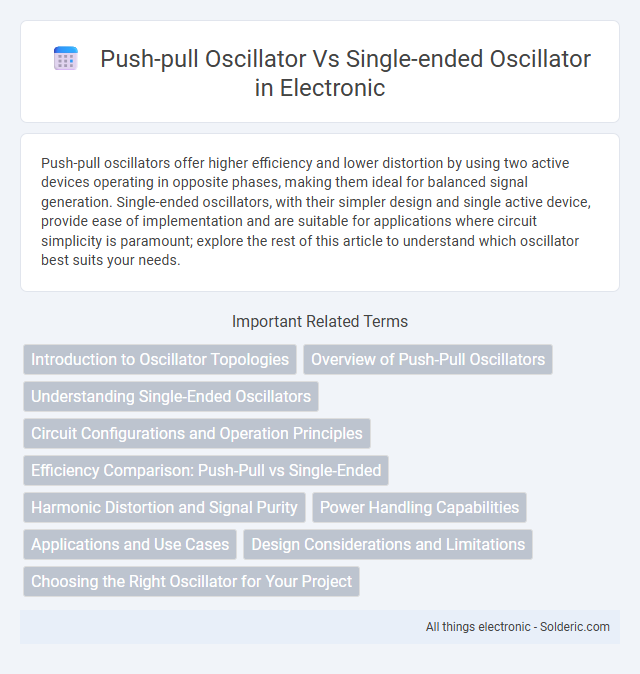Push-pull oscillators offer higher efficiency and lower distortion by using two active devices operating in opposite phases, making them ideal for balanced signal generation. Single-ended oscillators, with their simpler design and single active device, provide ease of implementation and are suitable for applications where circuit simplicity is paramount; explore the rest of this article to understand which oscillator best suits your needs.
Comparison Table
| Feature | Push-Pull Oscillator | Single-Ended Oscillator |
|---|---|---|
| Configuration | Uses complementary active devices in push-pull setup | Uses a single active device |
| Output Symmetry | Balanced, low even harmonics | Unbalanced, higher harmonics |
| Power Efficiency | Higher efficiency | Lower efficiency |
| Signal Amplitude | Higher output amplitude | Lower output amplitude |
| Complexity | More complex circuit | Simple design |
| Noise Immunity | Better noise rejection | More susceptible to noise |
| Applications | High-frequency, RF, and power oscillators | Low-frequency and simpler oscillators |
Introduction to Oscillator Topologies
Push-pull oscillator topologies utilize two active devices operating in opposite phases to achieve improved signal symmetry and reduced even harmonic distortion, making them ideal for high-frequency applications. Single-ended oscillators employ a single active device and simpler circuitry, offering ease of design but typically higher distortion and less efficient power usage. The choice between push-pull and single-ended oscillators depends on trade-offs between complexity, signal purity, and power efficiency in RF and analog signal generation.
Overview of Push-Pull Oscillators
Push-pull oscillators use a pair of active devices excited in opposite phases to generate a balanced output signal with reduced even harmonics and improved efficiency. Their design inherently cancels even-order distortion, providing higher output power and better spectral purity compared to single-ended oscillators. You benefit from enhanced stability and lower noise in applications requiring precise frequency generation.
Understanding Single-Ended Oscillators
Single-ended oscillators utilize a single active device to generate oscillations, making them simpler in design compared to push-pull oscillators that use two devices operating in opposite phases. They typically exhibit higher levels of even harmonic distortion due to the asymmetrical signal path, impacting signal purity. Understanding single-ended oscillators involves recognizing their straightforward architecture and the trade-offs in efficiency and linearity versus the push-pull configuration.
Circuit Configurations and Operation Principles
Push-pull oscillators use two active devices operating in opposite phases, creating a balanced output waveform with reduced even harmonics and improved efficiency. Single-ended oscillators rely on a single active device producing a waveform referenced to ground, often simpler but with higher distortion and lower power output. Your choice depends on whether harmonic purity and power efficiency are prioritized or simplicity and ease of implementation.
Efficiency Comparison: Push-Pull vs Single-Ended
Push-pull oscillators offer higher efficiency compared to single-ended oscillators due to their ability to reduce even-order harmonic distortion and cancel out common-mode signals, resulting in improved power output and lower power dissipation. Single-ended oscillators typically consume more power and generate higher harmonic distortion because only one transistor or active device drives the output, leading to lower overall efficiency. The push-pull configuration's balanced operation enhances linearity and thermal stability, making it preferred in applications requiring better efficiency and signal fidelity.
Harmonic Distortion and Signal Purity
Push-pull oscillators offer significantly lower harmonic distortion compared to single-ended oscillators due to their balanced design, which cancels even-order harmonics and enhances signal purity. Single-ended oscillators typically generate higher levels of distortion, resulting in a less pure output signal with more harmonic content. For your applications requiring clean and stable oscillations, push-pull configurations provide superior signal quality and reduced noise.
Power Handling Capabilities
Push-pull oscillators offer superior power handling capabilities compared to single-ended oscillators due to their ability to cancel even-order harmonics and reduce distortion. This results in more efficient power delivery and higher output levels, making push-pull designs suitable for applications requiring robust signal strength. Your choice should consider push-pull oscillators when maximizing power output and minimizing signal interference is critical.
Applications and Use Cases
Push-pull oscillators are widely used in high-power RF transmission and audio amplification due to their improved efficiency and reduced even-order harmonics, making them ideal for radio transmitters and power amplifiers. Single-ended oscillators find applications in low-power, low-noise, and precision systems such as sensors, clock generators, and instrumentation circuits where simplicity and signal purity are essential. The choice between push-pull and single-ended oscillators depends on the application's power requirements, signal quality, and harmonic distortion tolerance.
Design Considerations and Limitations
Push-pull oscillators offer improved power efficiency and reduced even-order harmonics by utilizing complementary active devices, but require precise device matching and symmetrical layout to minimize distortion and maintain frequency stability. Single-ended oscillators feature simpler design and smaller component count, making them suitable for low-power applications, yet they suffer from higher distortion and have limited output swing due to single device operation. The choice depends on trade-offs between linearity, power consumption, and complexity, with push-pull preferred in high-performance RF circuits and single-ended favorable for compact, low-cost designs.
Choosing the Right Oscillator for Your Project
Push-pull oscillators offer improved efficiency and reduced harmonic distortion compared to single-ended oscillators, making them ideal for applications requiring high power and signal purity. Single-ended oscillators are simpler in design and cost-effective, suited for low-power applications with less stringent performance needs. Your choice depends on project requirements such as power output, signal quality, and complexity, with push-pull oscillators favored for advanced RF systems and single-ended types for basic signal generation.
push-pull oscillator vs single-ended oscillator Infographic

 solderic.com
solderic.com